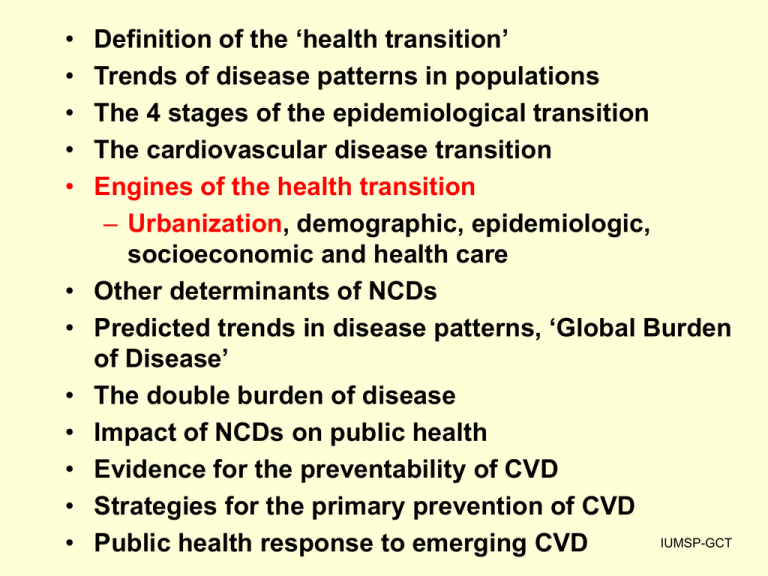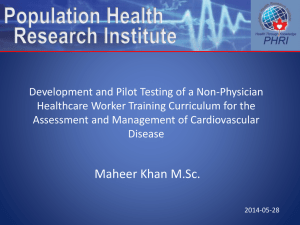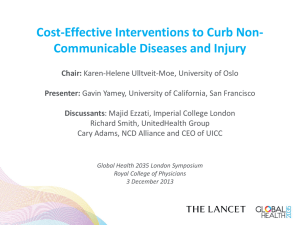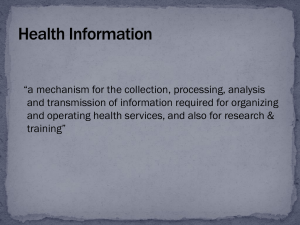Definition of the 'health transition'
advertisement

• • • • • • • • • • • • Definition of the ‘health transition’ Trends of disease patterns in populations The 4 stages of the epidemiological transition The cardiovascular disease transition Engines of the health transition – Urbanization, demographic, epidemiologic, socioeconomic and health care Other determinants of NCDs Predicted trends in disease patterns, ‘Global Burden of Disease’ The double burden of disease Impact of NCDs on public health Evidence for the preventability of CVD Strategies for the primary prevention of CVD IUMSP-GCT Public health response to emerging CVD Health transition: demographic transition and epidemiologic transition Industrialization & urbanization per cap. income, wealth Economic, social & environ mental changes levels of RF: fat, calories, tobacco, sedentary habits public sanitation, housing, health care NCD infectious diseases nutrition technology for health care mortality ( infant mortality) life expectancy fertility persons at at risk of developing NCDs Increasing and aging population IUMSP-GCT Percent of urban population Percent of urban population from 1970-2025 in industrialized and developing countries 100 1970 1994 2025 80 60 40 20 0 D e ve lo p e d F o rm e r so cia list co u n trie s e co n o m ie s D e velo p in g co un trieIUMSP-GCT s • • • • • Definition of the ‘health transition’ Trends of disease patterns in populations The 4 stages of the epidemiological transition The cardiovascular disease transition Engines of the health transition – Urbanization, demographic, epidemiologic, socioeconomic and health care • Other determinants of NCDs • Predicted trends in disease patterns, ‘Global Burden of Disease’ • The double burden of disease • Impact of NCDs on public health • Evidence for the preventability of CVD • Strategies for the primary prevention of CVD • Public health response to emerging CVD IUMSP-GCT Demographic transition: indicators over time (UK as an example of the ‘Western’ model) 40 Population Birth rate 50 40 • 30 Death rate 20 30 20 Population (m illions) Birth & death rates (per 1000) 50 Mortality rate • Fertility rate ( birth rate) • Size population • Age population 10 0 1800 1840 1880 1920 1960 10 0 IUMSP-GCT Models of demographic transition Heterogeneity of social and economic development among countries and over different periods of time leads to distinguish: • Classical (or Western) model – mostly economical and social factors, started in 18th-19th century • Accelerated model (Japan, Eastern Europe) – started later but evolved quicker • Delayed (or contemporary) model (most developing countries) – rapid decrease in overall mortality (mainly child deaths) but less (delayed) decrease in birth rates, hence explosive population growth – important role of public health and medical interventions IUMSP-GCT (treatment, contraception, abortion) Models of demographic transition Western 50 Accelerated (Japan, FSE) 50 50 Delayed (Most LDC) 100 50 80 40 12 40 40 40 9 Birth rate 30 30 30 60 30 6 Death rate 20 20 20 40 20 3 10 10 10 20 UK Japan 0 0 1800 1840 1880 10 1920 1960 Sri-Lanka 0 1800 0 1840 1880 1920 1960 0 1800 0 1840 1880 1920 1960 Mortality and birth rates driven to various extents by socio-economic development, public IUMSP-GCT health & medical interventions P opulation (millions) B irth & death rates (per 1000) Population Recent declines in fertility rates in various developing countries Thailand China Bangladesh Turkey Mexico Indonesia Brazil Egypt India Philippines Pakistan Nigeria 1965-70 1985-90 6.1 6.0 6.9 5.6 6.7 5.6 5.3 6.6 5.7 6.0 7.0 6.9 2.3 2.3 3.6 3.0 3.8 3.3 3.5 4.4 4.2 4.7 7.0 6.9 Prop. diff. (%). 62 62 48 46 43 41 34 33 26 21 0 0IUMSP-GCT Determinants of fertility rates High fertility • Economic needs of selfsufficient agrarian communities • Little striving for advancement • High child mortality • Religious doctrines and community sanctions • 'Individual' not important • Childbearing is major source of prestige and economic support for women Low fertility • Cost of children, earning power down • Reduced child mortality • Family and community less important for mobile city dwellers • Factory employment makes individual responsible for his/her own accomplishment • Education and rational point of view become important • Later marriage, migration, abortion, contraception IUMSP-GCT 8 ,0 0 0 6 ,0 0 0 1976 4 ,0 0 0 1990 2030 2020 2000 2 ,0 0 0 75+ 70-74 65-69 60-64 55-59 50-54 45-49 40-44 35-39 30-34 25-29 20-24 15-19 10-14 5-9 0 0-4 Population per 5-year category Demographic transition in Seychelles: 3-fold increase of the number of people 50-70 by 20201 0 30 ,0 0 0 (hence expected large increase in NCDs) IUMSP-GCT Ag e c a te g o ry Aging populations: trends in number of persons (millions) aged 60 1950 Brazil Mexico Nigeria Indonesia China Bangladesh Japan India USSR USA Italy Germany 2 1 1 4 42 3 6 32 16 19 6 7 1975 6 3 3 7 74 3 13 30 34 32 10 12 2000 14 7 6 15 135 7 26 66 54 40 14 13 2025 32 18 16 31 284 17 33 146 71 67 16 15 Increase (fold) 1950-2025 15 13 12 8 7 6 6 5 4 4 3 IUMSP-GCT 2 Impact of growing and aging populations in industrialized and developing countries World population structure by region, 1950-1990 Increase (fold) 1950-1990 6000 W es t As ia (3.1) 5000 S outh As ia (2.5) Millions 4000 S E As ia (2.5) E as t As ia (2.0) Afric a (3.0) 3000 2000 S . Am eric a (2.7) N. Am eric a (1.7) 1000 0 1950 1960 1970 1980 1990 E x-US S R (1.6) E urope (1.2) IUMSP-GCT • • • • • Definition of the ‘health transition’ Trends of disease patterns in populations The 4 stages of the epidemiological transition The cardiovascular disease transition Engines of the health transition – Urbanization, demographic, lifestyle, socioeconomic and health care • Other determinants of NCDs • Predicted trends in disease patterns, ‘Global Burden of Disease’ • The double burden of disease • Impact of NCDs on public health • Evidence for the preventability of CVD • Strategies for the primary prevention of CVD • Public health response to emerging CVD IUMSP-GCT Lifestyle transition • Behaviors (e.g. smoking, sedentary habits) • Nutritional transition (e.g. fats, complex carbohydrates) – industrialization – urbanization – globalization of world markets and mass media IUMSP-GCT Changes in cigarettes consumption (sales) in developing and developed countries, 1974-1992 China: 390% 200 C hina S o uth K o re a 150 India 100 India Tha ila nd US A UK 50 UK C a na da 1990 1988 1986 1984 1982 1980 1978 1976 0 1974 Percent change (% ) Thailand IUMSP-GCT Nutritional transition: rapid adoption of a high fat diet, China 100% Proportion of pers ons with >30% fat diet (%) 1989 1993 80% 60% 40% 20% 0% H ig h e r in c o m e M id d le in c o m e e a rn e rs e a rn e rs L o w in c o m e e a IUMSP-GCT rn e rs Higher levels of several risk factors in Seychelles than in Switzerland (age 35-64, 1989-1991) Females Males Hypertension (>160/95 or tt) Smoking (>1 cig/day) 15 35 34 Blood total (>6.5) cholesterol Blood HDL- <0.9 mmol/l cholesterol Blood >300 mg/l lipoprotein(a) 11 14 53 13 5 Obesity (BMI>30) 46 2 39 Seychelles Switzerland 8 33 13 11 12 35 28 7 5 7 5 Diabetes 24 20 11 12 10 30 (diff. criteria) 0 20 40 60 Prevalence (%) 0 20 40 60 IUMSP-GCT Prevalence (%) Increasing levels of several risk factors in a rapidly developing country, Seychelles, 1989-1994 Males High cholesterol (>6.5) 11 Females 21 20 42 Hypertension (>160/95) 27 24 31 41 Smoking 32 8 54 12 1994 8 7 Diabetes (diff. criteria) Obesity (BMI>30) 5 5 7 10 34 29 14 Heavy exercise at work 2 36 Leisure exercise weekly 3 0 1989 20 18 13 2 20 40 Prevalence (%) 60 0 20 40 IUMSP-GCT Prevalence (%) 60 Prevalence of overweight and obesity in children, age 5-17, in developed and developing countries (using same criteria) Overweight Obesity 20 Girls Boys Proportion (%) 16 12 8 4 Seychelles Brazil Hong Kong Singapore Netherlands UK USA Seychelles Brazil Hong Kong Singapore Netherlands UK USA 0 IUMSP-GCT Prevalence of high systolic blood pressure in children, age 5-17, Seychelles and USA (using same criteria) 20 'High normal' 'Hypertension' Prevalence (%) 15.3 14.0 15 10 US 10 Seychelles 10 9.5 8.3 5 5 Boys GirlsIUMSP-GCT 5 0 Boys Girls • • • • • Definition of the ‘health transition’ Trends of disease patterns in populations The 4 stages of the epidemiological transition The cardiovascular disease transition Engines of the health transition – Urbanization, demographic, lifestyle, socioeconomic and health care • Other determinants of NCDs • Predicted trends in disease patterns, ‘Global Burden of Disease’ • The double burden of disease • Impact of NCDs on public health • Evidence for the preventability of CVD • Strategies for the primary prevention of CVD • Public health response to emerging CVD IUMSP-GCT Socioeconomic transition in disease patterns: early- vs. late-adopter communities E a rly a d o p te r c o m m u n ity L a te a d o p te r C VD mo rta lity c o m m u n ity A g e o f o ns e t o f A g e o f o ns e t of d e g e ne ra tive a nd d e la ye d d e g e ne ra tive m a nm a d e d is e a s e s d is e a s e s Time IUMSP-GCT Rural-urban differences in levels of risk factors (Shanghai region, 1985) Height (m) Urban Hongku (n=1591) 1.62 Rural, Baoshan (n=1200) 1.58 Weight (kg) 59.2 54.5 Body mass index (kg/m2) 22.4 21.5 SBP (mm Hg) 125 119 DBP (mmHg) 80 76 164.3 158.4 Cholesterol (mg/dl) IUMSP-GCT Socio-economic differential in risk factor levels (random sample of 9254 adults of Dar es Salaam, 1999) SES indicators Prevalence Body mass Systolic BP OR for in index index (kg/m2) (mmHg) smoking category (adusted for age (adjusted for (adjusted for & sex) age, sex & BMI) sex & age) (%) Education Secondary or more vs non manual unskilled 22 +1.48 -5.3 0.72 Occupation Non manual skilled vs. manual unskileed 7 +0.66 -2.7 0.40 Refrigerator at home vs. not 18 +1.44 -1.5 0.52 • Flush toilet at home vs. latrine 15 +1.21 -2.1 0.63 Wealth Some issues related to socioeconomic transition Equity • access to information & health care related to RF and NCDs • costs related to adopting healthy behaviors/lifestyles • costs of treatment for chronic NCDs Socioeconomic differences within populations • pockets of underdevelopment within western countries • large variations in development within developing countries Forward and backward dynamic of development • underdevelopment can follow phases of IUMSP-GCT development (e.g. FSE) • • • • • Definition of the ‘health transition’ Trends of disease patterns in populations The 4 stages of the epidemiological transition The cardiovascular disease transition Engines of the health transition – Urbanization, demographic, lifestyle, socioeconomic and health care • Other determinants of NCDs • Predicted trends in disease patterns, ‘Global Burden of Disease’ • The double burden of disease • Impact of NCDs on public health • Evidence for the preventability of CVD • Strategies for the primary prevention of CVD • Public health response to emerging CVD IUMSP-GCT Health care transition • Availability of preventive and curative services – immunization, contraception, maternal/child care, antibiotics • Large influence on the dynamics of demographic transition – e.g. ‘delayed transition model’ in many developing countries (decrease in infant mortality not followed by proportionate decrease in birth/fertility rates: population increase ++) • Large heterogeneity between populations due to costs and efficiency in allocation of health services IUMSP-GCT Burden of disease and health expenditures in industrialized and developing countries: the '90/10 desequilibrium' 100% 7 Percent 80% 60% Health expenditur 93 87 40% DALYs 20% 13 0% EME All other IUMSP-GCT Aid disbursements for health by type of disease burden: current low priority given to NCDs Disease % of DALYs Funds in $ (million) $ per DALY Communicable, maternal and perinatal 50 807 1.32 Non-communicable 38 74 0.16 Injuries 12 9 0.06 IUMSP-GCT Allocation of resources for NCD control concentrates on equipment, not on prevention (Growth in medical equipment imports in one state of India) 1981 1992 Electromedical equipment 1.4 61.0 X-ray apparatus 8.6 17.3 Other medical/surgical 25.6 24.2 Item In millions $ IUMSP-GCT





